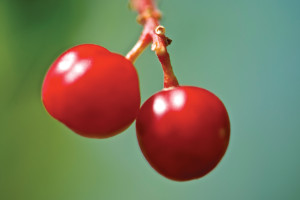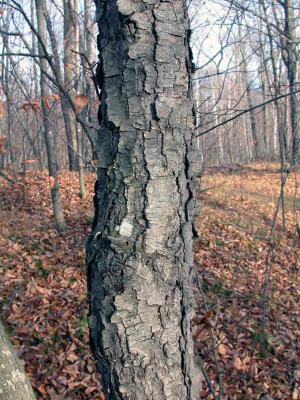Wild Cherry Tree
- Share
- Tweet
- Pin
- Share

With Door County being one of the prime tart cherry producing areas in North America, most people tend to overlook the most common wild cherry trees that are native to our county and state. All of the three main species – Black Cherry, Chokecherry and Pin Cherry – produce fruit relished by quite a few native songbirds, such as Ruffed Grouse, Gray Catbird, American Crow, Rose-breasted Grosbeak, Starling, Brown Thrasher and the Pileated Woodpecker, plus a few mammals, including Black Bears, both foxes, Cottontail Rabbits, raccoons, squirrels and chipmunks.
I was tricked at a very young age into eating a Chokecherry fruit, immediately grimaced, turned up my nose and promptly spit it out. Thereafter, through the years I too have politely tricked friends, who had never tasted one of the rather bitter fruits, into sampling one.

Photo by Len Villano.
It has been said that if one waits until the Chokecherry fruit is completely ripe, they really do have a somewhat sweet and pleasant flavor. My mother did a great deal of canning for our large family, and I do recall her making a delicious jam or jelly by mixing Chokecherry fruit with apple.
Chokecherry trees are almost always quite small; they’re more often large shrubs, and are very abundant in our region so the fruit is always easy to gather.
In caressing the smooth trunk of a young Black Cherry tree I picture its lovely clusters of white flowers. One of the twigs, when broken in two, reveals its unmistakable bitter almond aroma so typical of this widespread member of the rose family. Their trunks become quite rough textured as the tree ages. One of the nicknames of the mature, easily identified tree with the bark having upturned edges of its individual scales, is the “potato-chip” tree.
There are 10 genera and at least 74 species of trees representing the rose family in the U.S.
Included are the Serviceberry, Cherry, Plum, Peach, Mountain Ash, Hawthorn, Chokecherry, Black Cherry, Pin Cherry and Mahaleb Cherry (not native to North America). Some of the trees go by different colloquial names such as the Juneberry or Shadbush for the Serviceberry, Thornapple for Hawthorn and Fire Cherry for Pin Cherry.

Black Cherry bark
The genus of the Black Cherry is Prunus, the ancient name of the plum. The species name of the Black Cherry is Serotina (se-ROE-ti-na), meaning appearing late, in that its flowers appear only after its leaves have emerged, unlike the commercial cherries that come into bloom before the foliage appears.
Several years ago I sampled the fruit from a dozen or more Black Cherry trees and learned that their sweetness varied considerably. I also came to realize that many of the fruits have the tiniest of “worms,” actually caterpillars (larvae) in them. However, I usually eat plenty of the cherries fresh from the best tree regardless of their inside residents. The tiny larvae probably taste like the cherries themselves, and the added protein possibly provides one with more nutrition than do the fruits themselves.
Another attribute of the Black Cherry tree is its unusual hardiness. They will survive in frost pockets where few other trees can. So many of our Black Cherry trees are open grown, along stone fence-lines for example, where they’ve been planted by birds or raccoons (via their droppings). As a result, these trees invariably are short-trunked, wide-crowned, knotty and limby. However, a tree such as this in full flower, or in fruit, is a thing of exquisite beauty.
To be tall and straight, Black Cherry trees must be forest-grown where they have been forced by competition to grow upward toward the light rather than outward. Our state’s champion in Walworth County is a little more than 61 feet tall, has a crown spread averaging 57 feet wide and an enormous trunk 17 ½ feet in circumference at 4 ½ feet above the ground.

Black Cherry branch
Door County’s champion has two trunks that divide about two feet from the ground, so only the largest of the trunks could be measured. Its circumference is 89 inches (a little less than 7 ½ feet), its height is 75 feet and its average crown spread is 37 feet. Black Cherry wood is second in value to Black Walnut in temperate North America when it comes to prized cabinet-making lumber. In fact this tree is the only commercial timber-producing member of the rose family.
Its pink to light brown heartwood is medium-hard, takes a mirror-like polish and shrinks very little as it seasons. The fact that it finishes so splendidly and does not warp once it is dry makes it a much sought after product. Both Charlotte and I are very fond of the two pieces of furniture we had custom-made from Black Cherry lumber.
It is natural that so many people get confused in the identity of the Black Cherry versus the Chokecherry. Small, open-grown trees can be very similar. Obviously one taste of the fruit will be a giveaway, but trees in flower and in fruit appear to look alike in most respects.
Consider these three points: Chokecherry blooms a week to 10 days earlier than Black Cherry. The leaves of the Black Cherry have incurved leaf-margin teeth while the Chokecherry leaves have fine saw-tooth margins. Leaves of the Black Cherry are usually densely hairy along the midrib near the base.

Black Cherry flowers
Even the unripened fruits of both the Black and Chokecherry trees have an interesting feature to aid in their accurate identification. The tiny five-pointed flower calyx persists on top of the fruit of the Black Cherry all during its development and ripening. These star-shaped calyxes are entirely missing on Chokecherry fruits.
Another nickname for the Black Cherry, the “Rum Cherry,” came about years ago when its fruit was a favorite for flavoring rum or brandy. This led to the familiar drink called “cherry bounce.”
If I were you, I’d hone up on the flamboyant tree members of the great rose family. Then, come mid-May, bounce outdoors to enjoy one of the most beautiful spectacles in northeastern Wisconsin’s spring woods, wild Serviceberry and Cherry blossom time.
Photography by Roy Lukes.

